The Gibson SG is a model of solid-bodied electric guitar that was introduced in 1961 by Gibson, and remains popular in the present day.
Origins
In 1958, Gibson Les Paul sales were significantly lower than they had been in previous years. The following year, the Les Paul was given a thinner, flat-topped mahogany body, and had a double cutaway which made the upper frets more accessible. The neck joint was moved by three frets to further ease access to the upper frets.
Production costs fell significantly due to the simpler body construction, and the new Les Paul was advertised as having the "fastest neck in the world" due to its slender neck profile and small heel. The new Les Paul was popular, but Les Paul himself did not care for the new design, and requested the removal of his name from the new model (however, due to his contract, he was photographed with the new model several times).
Gibson honored Les Paul's request, and the new model was named "SG", which stood for 'Solid Guitar'. Even though Les Paul's name was officially deleted in 1961, the SG featured Les Paul nameplates and truss rod covers until the end of 1963.
Due to its popularity and vintage heritage, the body style of the SG is often copied by other manufacturers, although much less frequently than the Les Paul and the Fender Stratocaster; a notable example is the ESP Viper.
Design
The SG generally has a solid mahogany body, with a black "bat-wing" pickguard. The 24.75" scale mahogany neck joins the body at the 19th fret. The SG's set neck is shallower than the Gibson Les Paul's, but features the traditional Gibson combination of two humbucker pickups and a Tune-O-Matic bridge assembly (or vibrato tailpiece, depending on the model).
The SG Standard features white trapezoid fretboard inlays, as well as fretboard binding and inlaid "Gibson" logo; the SG Special omits these features, instead using cheaper white dot inlays and a silk-screened logo. The Standard has a volume and a tone control for each individual pickup, and a three-way switch that allows the player to select either the bridge pickup, the neck pickup, or both together. The SG does not include switching to coil tap the humbuckers in stock form (with the exception of the Guitar Center-exclusive SG Standard), although this is a popular player modification.
Some models use body woods other than mahogany; examples include the Swamp Ash SG Special and SG Voodoo, the 2009 Raw Power, and some walnut bodied 1970s models. High-end models occasionally sport decorative maple caps, carved tops, and gold hardware.
Models and variations
At the launch of the SG in 1961, Gibson offered four variants of the SG; the SG Junior (a stripped-down version of the standard, analogous to the Les Paul Junior), the SG Special, the SG Standard, and the top-of-the-line SG Custom. However, Gibson's current core variants as of 2010 are the SG Standard and the SG Special. Over the years, Gibson has offered many variations of the SG, and continues to manufacture special editions, including models such as the Special and Faded Special, Supreme, Artist Signature SGs, Menace, and Gothic, as well as the premium-priced VOS reissues of the sixties SG Standard and Custom.
Models produced between 1961 and 1965 have the original small pickguard; in 1966 the guitar was redesigned slightly with a different neck joint, and the modern larger semi-symmetrical "batwing" pickguard first appeared in 1967. This design continued until 1971, when variations of the SG were sold with a raised Les Paul style pickguard and a front-mounted control plate. The low-end SG-100 and the P-90 equipped SG-200 appeared during this time, as well as the luxurious SG Pro and SG Deluxe guitars. Vibrato (tremolo arm) tailpieces were also introduced as options.
In 1972 the design went back to the original style pickguard and rear-mounted controls but with the neck now set further into the body, joining roughly at the 20th fret. By the end of the seventies, the SG models returned to the original sixties styling, and modern (1991-present) standard and special models have mostly returned to the 1967-1969 styling and construction, with a few exceptions; various reissues and other models of the SG still retain the original 1961-1967 styling.
In 1980, the first SG manufactured with "active" factory pickups was introduced. Gibson experimented with an SG that included the same Moog active electronics that had previously been used in another Gibson model, the RD Artist. The resulting SG had a slightly thicker body to accommodate the extra circuitry, and was dubbed the “Gibson SG-R1.” The SG-R1 was renamed the “SG Artist” in 1981, and was discontinued shortly afterwards. Approximately 200 active SGs were produced.
In 2008, Gibson introduced the Robot SG, which feature a motorized tuning system developed by Tronical. Limited-edition variants include the SG Robot Special and the limited-edition Robot SG LTD. The Robot system was designed to be convenient for players who need to frequently change tunings, without requiring them to manually tune or carry several guitars; however, they also carry a significant price premium.
In 2009, Gibson introduced the Raw Power line of SGs, which have an all-maple body, unbound maple neck and fretboard, and unique colors not previously seen in SGs. These models are priced between the entry-level Specials and the more expensive Standards. 2009 also brought the Guitar Center-exclusive SG Standard with Coil Taps available in both 50s and 60s style necks.
Gibson's EB-3, EB-0, EDS-1275, and later model of Melody Maker and Kalamazoo also shared or once shared SG-shaped bodies, but these are not the members of the SG family.
Epiphone also offers a range of value-priced models, including a model with 1960's styling, sold as the G-400. These models feature simpler construction and a lower build quality than their Gibson counterparts, although they also implement a number of features missing from production Gibson models; examples include the 22" scale SG Express, the metal-oriented Prophecy line (equipped with high-output humbuckers and unique inlays), and a replica of the Gibson EDS-1275, popularized by Jimmy Page.
Unique SGs
Eric Clapton used a 1964 Gibson SG Standard starting in 1967 while in Cream. This guitar was known as the "Fool" guitar, as it was painted by the Dutch artists known collectively as The Fool. In spring 1968, the SG was loaned to Jackie Lomax, an associate of George Harrison. The "Fool" was later sold to Todd Rundgren for $500 before eventually being sold to a private collector for about $500,000.
Tony Iommi of Black Sabbath owns several custom-made black left-handed Gibson SGs with white cross-shaped fretboard inlays. Epiphone produces a similar guitar as the Tony Iommi G-400.
John Cipollina of Quicksilver Messenger Service used a custom Gibson SG with custom pickguards in the shape of bat-like figures, as well as the fret board being customized with unique patterns.
Gibson USA
SG '61 Reissue
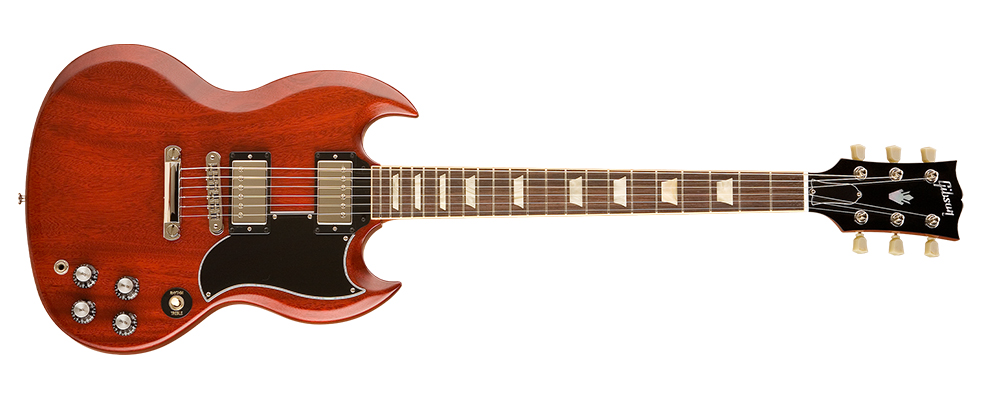
Epiphone
G-400
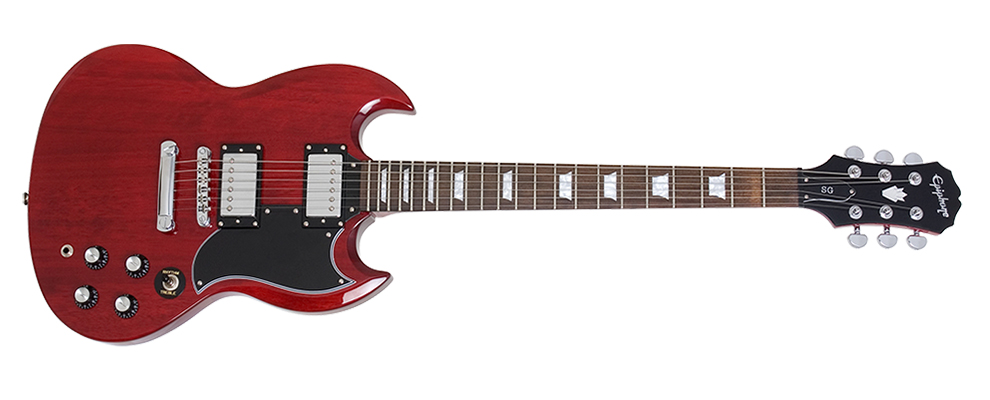
Gibson USA
SG Special '60s Tribute
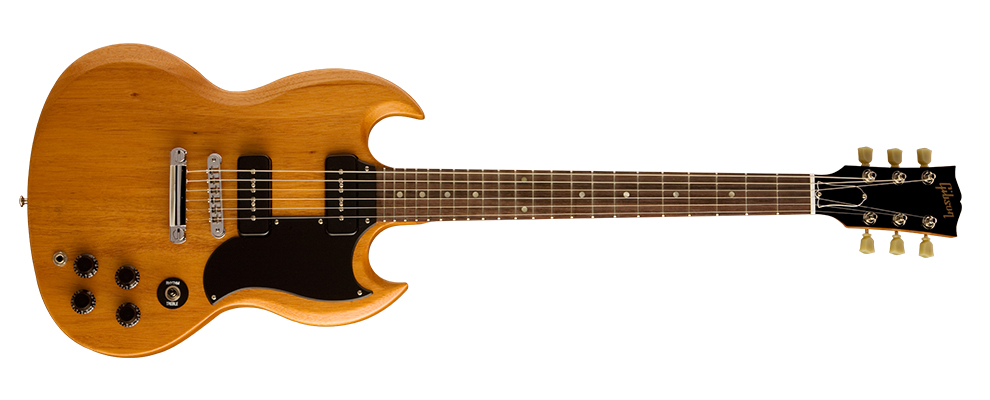
Gibson USA
SG Gothic Morte
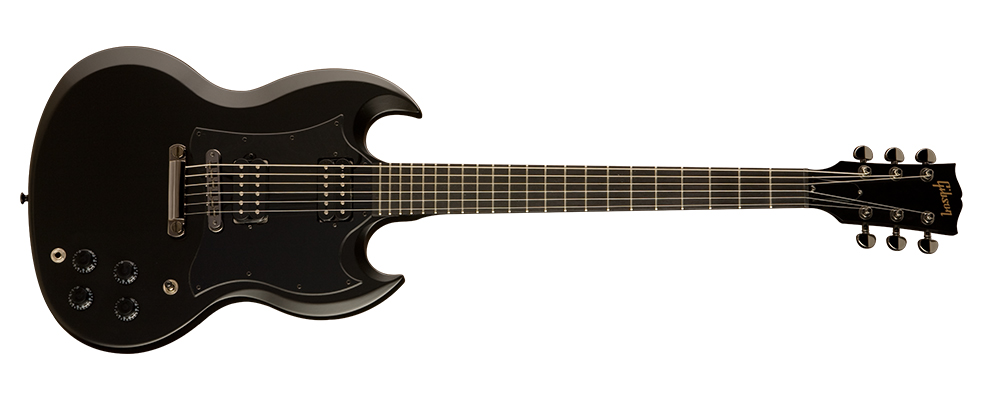
Gibson USA
SG Standard
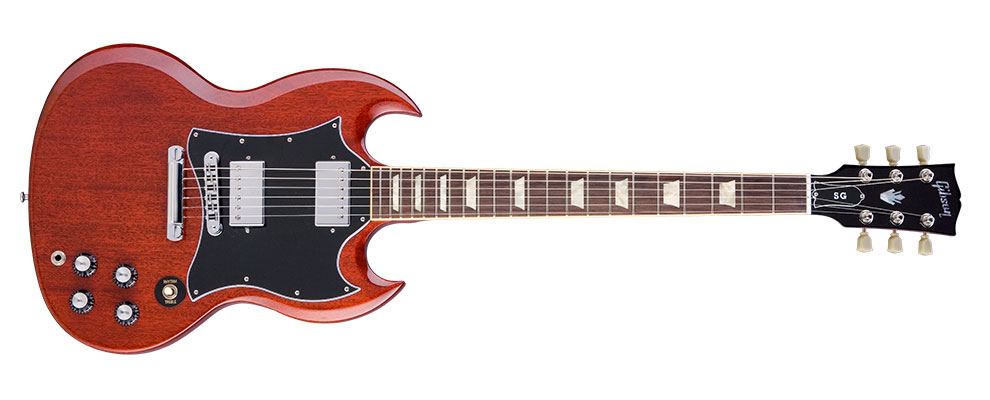
Gibson USA
50th Anniversary SG Standard 24
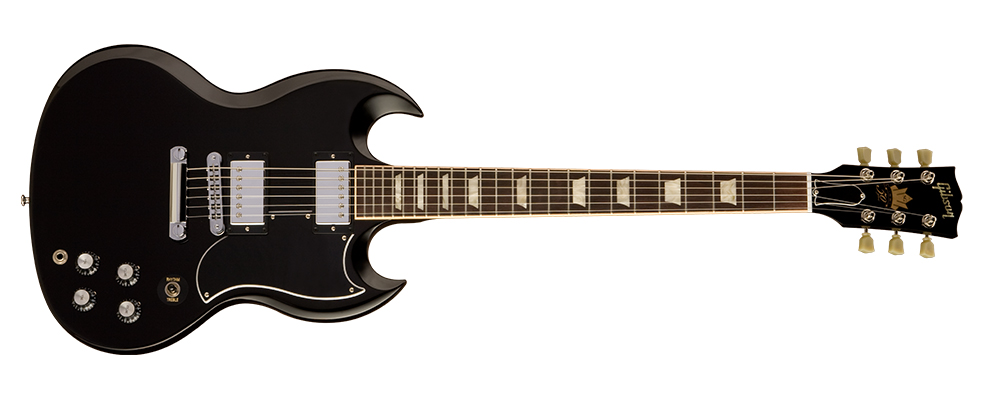
Gibson USA
Melody Maker SG
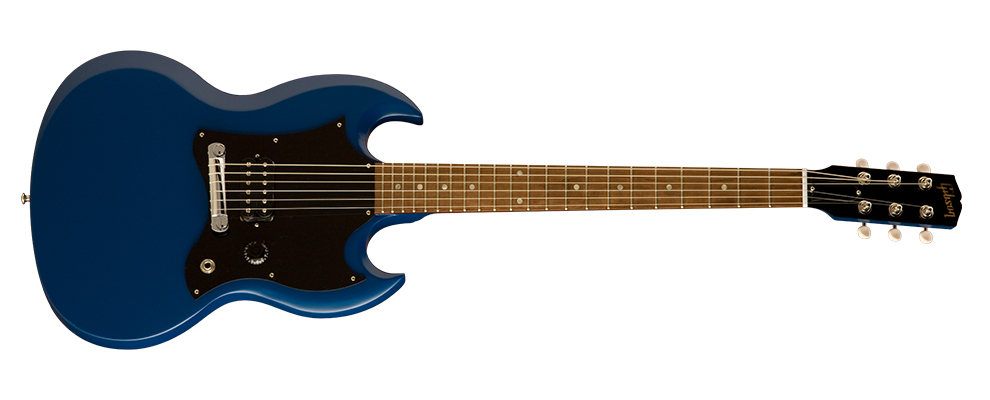
Gibson USA
50th Anniversary SG 12-String
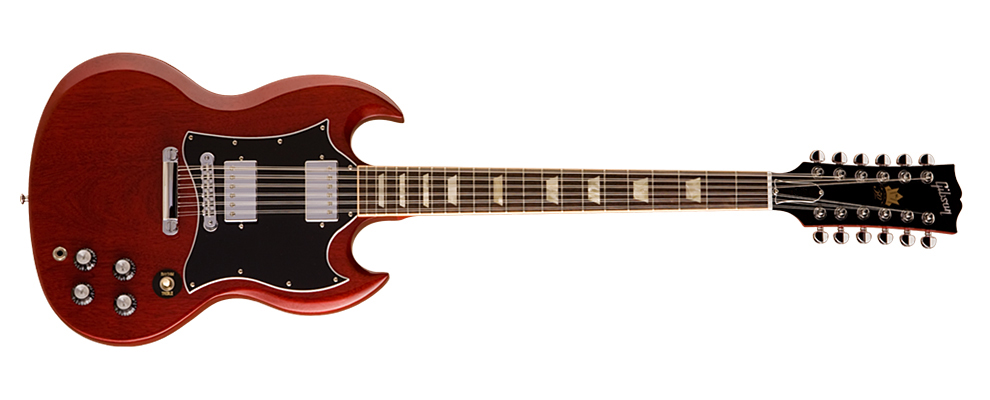
Gibson USA
SG Special Faded
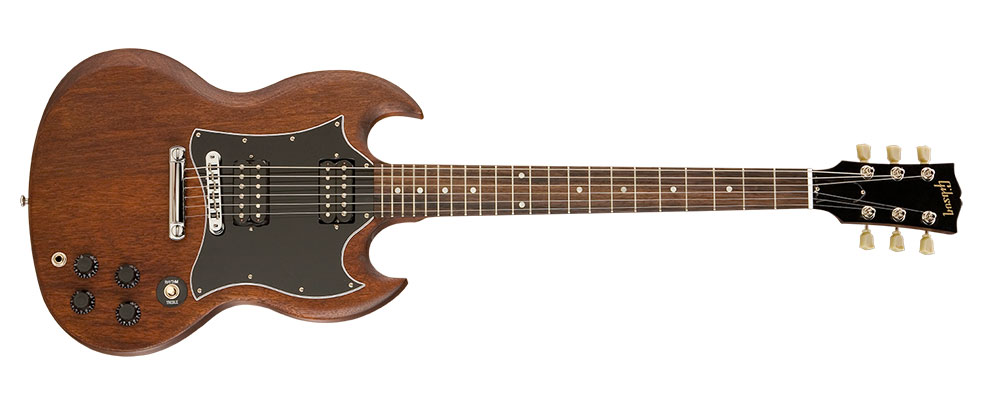
Gibson USA
SG Special
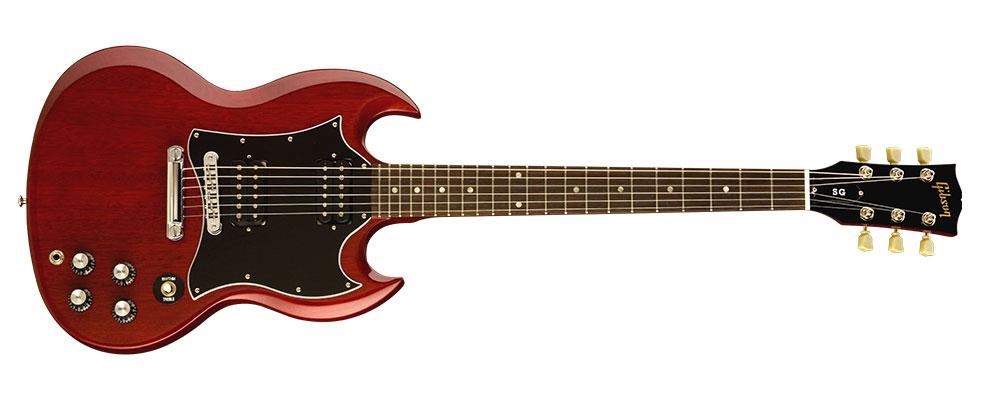
Gibson USA
SG Classic Faded

Gibson Custom
Don Felder "Hotel California" EDS-1275
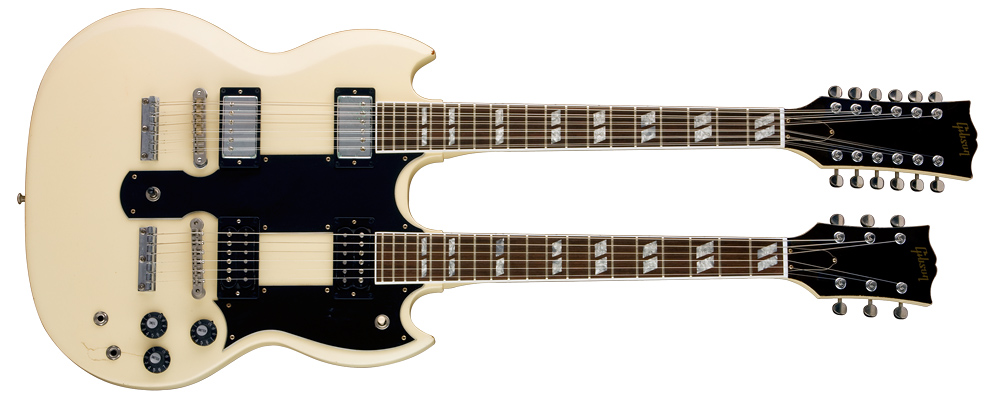
Gibson USA
50th Anniversary Robby Krieger SG
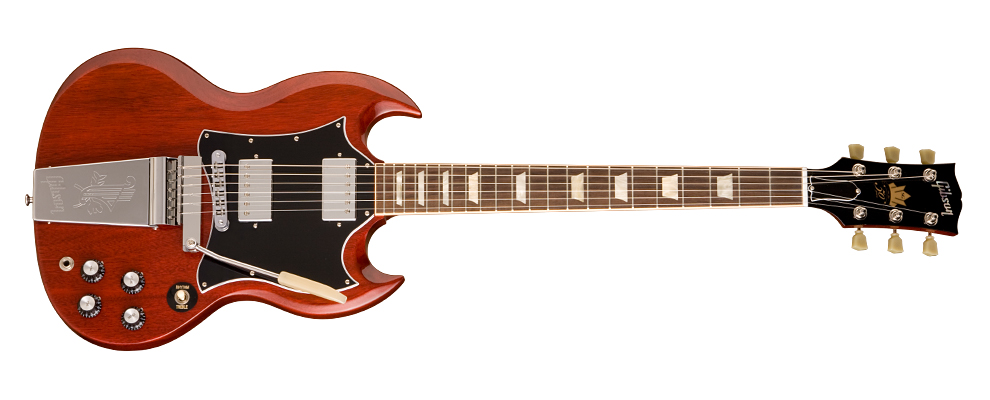
Gibson USA
Angus Young SG
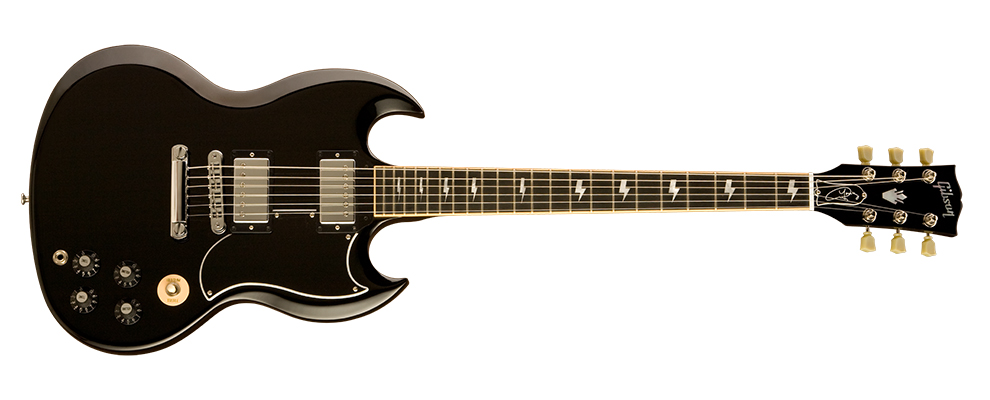
Gibson Custom
Angus Young SG Standard
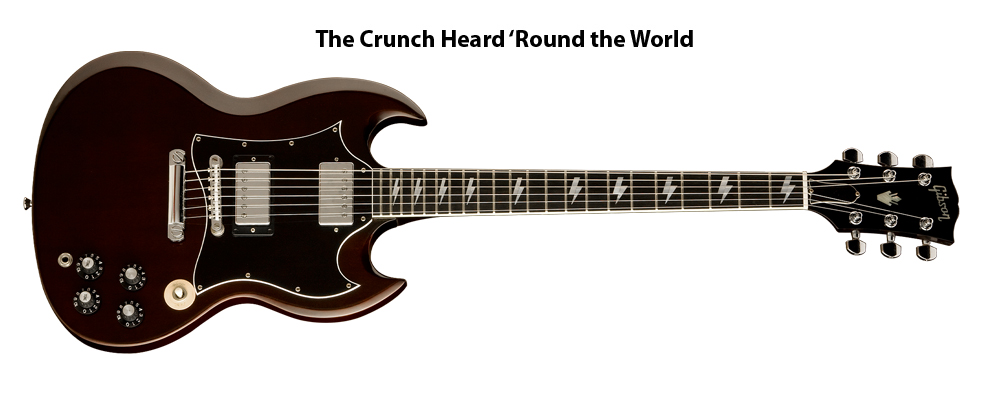
Gibson Custom
SG Custom with Maestro VOS
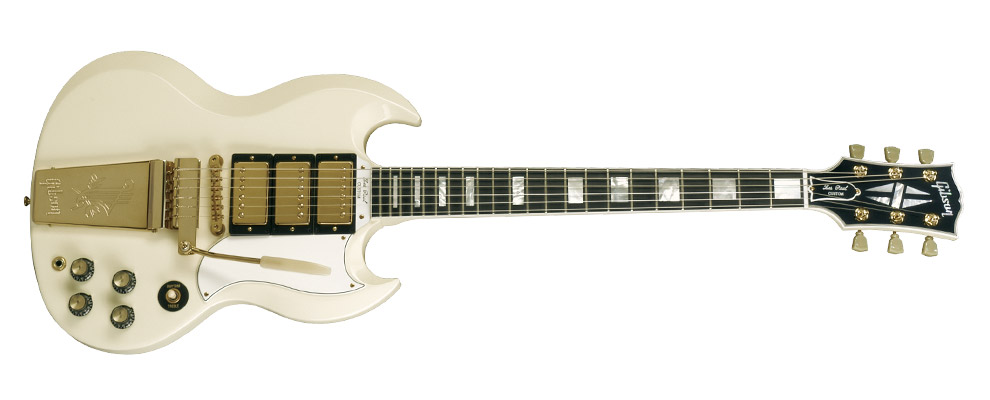
Origins
In 1958, Gibson Les Paul sales were significantly lower than they had been in previous years. The following year, the Les Paul was given a thinner, flat-topped mahogany body, and had a double cutaway which made the upper frets more accessible. The neck joint was moved by three frets to further ease access to the upper frets.
Production costs fell significantly due to the simpler body construction, and the new Les Paul was advertised as having the "fastest neck in the world" due to its slender neck profile and small heel. The new Les Paul was popular, but Les Paul himself did not care for the new design, and requested the removal of his name from the new model (however, due to his contract, he was photographed with the new model several times).
Gibson honored Les Paul's request, and the new model was named "SG", which stood for 'Solid Guitar'. Even though Les Paul's name was officially deleted in 1961, the SG featured Les Paul nameplates and truss rod covers until the end of 1963.
Due to its popularity and vintage heritage, the body style of the SG is often copied by other manufacturers, although much less frequently than the Les Paul and the Fender Stratocaster; a notable example is the ESP Viper.
Design
The SG generally has a solid mahogany body, with a black "bat-wing" pickguard. The 24.75" scale mahogany neck joins the body at the 19th fret. The SG's set neck is shallower than the Gibson Les Paul's, but features the traditional Gibson combination of two humbucker pickups and a Tune-O-Matic bridge assembly (or vibrato tailpiece, depending on the model).
The SG Standard features white trapezoid fretboard inlays, as well as fretboard binding and inlaid "Gibson" logo; the SG Special omits these features, instead using cheaper white dot inlays and a silk-screened logo. The Standard has a volume and a tone control for each individual pickup, and a three-way switch that allows the player to select either the bridge pickup, the neck pickup, or both together. The SG does not include switching to coil tap the humbuckers in stock form (with the exception of the Guitar Center-exclusive SG Standard), although this is a popular player modification.
Some models use body woods other than mahogany; examples include the Swamp Ash SG Special and SG Voodoo, the 2009 Raw Power, and some walnut bodied 1970s models. High-end models occasionally sport decorative maple caps, carved tops, and gold hardware.
Models and variations
At the launch of the SG in 1961, Gibson offered four variants of the SG; the SG Junior (a stripped-down version of the standard, analogous to the Les Paul Junior), the SG Special, the SG Standard, and the top-of-the-line SG Custom. However, Gibson's current core variants as of 2010 are the SG Standard and the SG Special. Over the years, Gibson has offered many variations of the SG, and continues to manufacture special editions, including models such as the Special and Faded Special, Supreme, Artist Signature SGs, Menace, and Gothic, as well as the premium-priced VOS reissues of the sixties SG Standard and Custom.
Models produced between 1961 and 1965 have the original small pickguard; in 1966 the guitar was redesigned slightly with a different neck joint, and the modern larger semi-symmetrical "batwing" pickguard first appeared in 1967. This design continued until 1971, when variations of the SG were sold with a raised Les Paul style pickguard and a front-mounted control plate. The low-end SG-100 and the P-90 equipped SG-200 appeared during this time, as well as the luxurious SG Pro and SG Deluxe guitars. Vibrato (tremolo arm) tailpieces were also introduced as options.
In 1972 the design went back to the original style pickguard and rear-mounted controls but with the neck now set further into the body, joining roughly at the 20th fret. By the end of the seventies, the SG models returned to the original sixties styling, and modern (1991-present) standard and special models have mostly returned to the 1967-1969 styling and construction, with a few exceptions; various reissues and other models of the SG still retain the original 1961-1967 styling.
In 1980, the first SG manufactured with "active" factory pickups was introduced. Gibson experimented with an SG that included the same Moog active electronics that had previously been used in another Gibson model, the RD Artist. The resulting SG had a slightly thicker body to accommodate the extra circuitry, and was dubbed the “Gibson SG-R1.” The SG-R1 was renamed the “SG Artist” in 1981, and was discontinued shortly afterwards. Approximately 200 active SGs were produced.
In 2008, Gibson introduced the Robot SG, which feature a motorized tuning system developed by Tronical. Limited-edition variants include the SG Robot Special and the limited-edition Robot SG LTD. The Robot system was designed to be convenient for players who need to frequently change tunings, without requiring them to manually tune or carry several guitars; however, they also carry a significant price premium.
In 2009, Gibson introduced the Raw Power line of SGs, which have an all-maple body, unbound maple neck and fretboard, and unique colors not previously seen in SGs. These models are priced between the entry-level Specials and the more expensive Standards. 2009 also brought the Guitar Center-exclusive SG Standard with Coil Taps available in both 50s and 60s style necks.
Gibson's EB-3, EB-0, EDS-1275, and later model of Melody Maker and Kalamazoo also shared or once shared SG-shaped bodies, but these are not the members of the SG family.
Epiphone also offers a range of value-priced models, including a model with 1960's styling, sold as the G-400. These models feature simpler construction and a lower build quality than their Gibson counterparts, although they also implement a number of features missing from production Gibson models; examples include the 22" scale SG Express, the metal-oriented Prophecy line (equipped with high-output humbuckers and unique inlays), and a replica of the Gibson EDS-1275, popularized by Jimmy Page.
Unique SGs
Eric Clapton used a 1964 Gibson SG Standard starting in 1967 while in Cream. This guitar was known as the "Fool" guitar, as it was painted by the Dutch artists known collectively as The Fool. In spring 1968, the SG was loaned to Jackie Lomax, an associate of George Harrison. The "Fool" was later sold to Todd Rundgren for $500 before eventually being sold to a private collector for about $500,000.
Tony Iommi of Black Sabbath owns several custom-made black left-handed Gibson SGs with white cross-shaped fretboard inlays. Epiphone produces a similar guitar as the Tony Iommi G-400.
John Cipollina of Quicksilver Messenger Service used a custom Gibson SG with custom pickguards in the shape of bat-like figures, as well as the fret board being customized with unique patterns.
Gibson USA
SG '61 Reissue

Epiphone
G-400

Gibson USA
SG Special '60s Tribute

Gibson USA
SG Gothic Morte

Gibson USA
SG Standard

Gibson USA
50th Anniversary SG Standard 24

Gibson USA
Melody Maker SG

Gibson USA
50th Anniversary SG 12-String

Gibson USA
SG Special Faded

Gibson USA
SG Special

Gibson USA
SG Classic Faded

Gibson Custom
Don Felder "Hotel California" EDS-1275

Gibson USA
50th Anniversary Robby Krieger SG

Gibson USA
Angus Young SG

Gibson Custom
Angus Young SG Standard

Gibson Custom
SG Custom with Maestro VOS


No comments:
Post a Comment